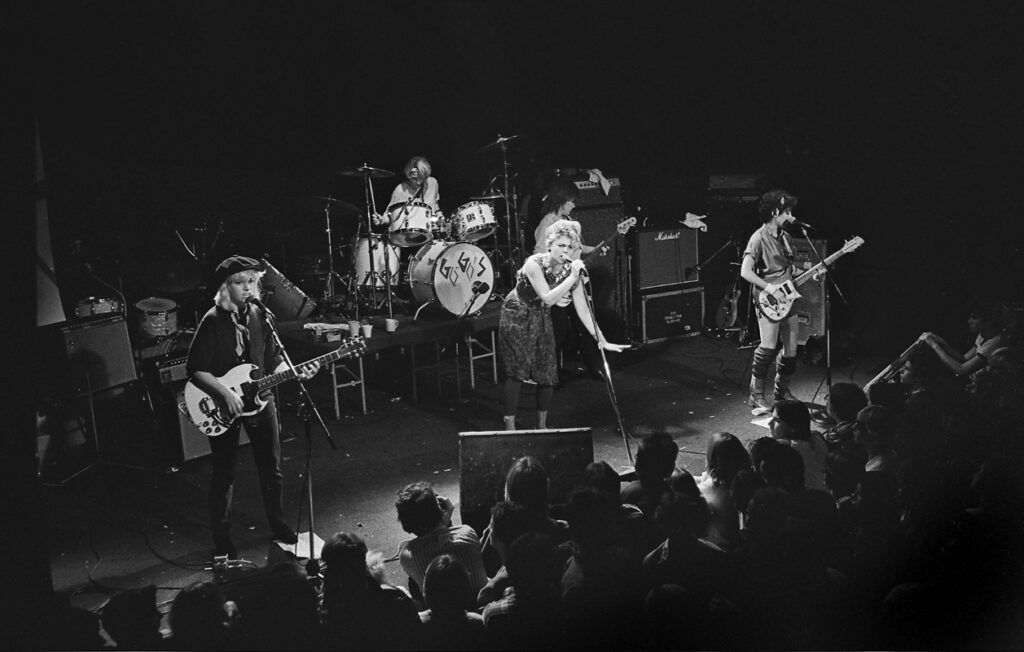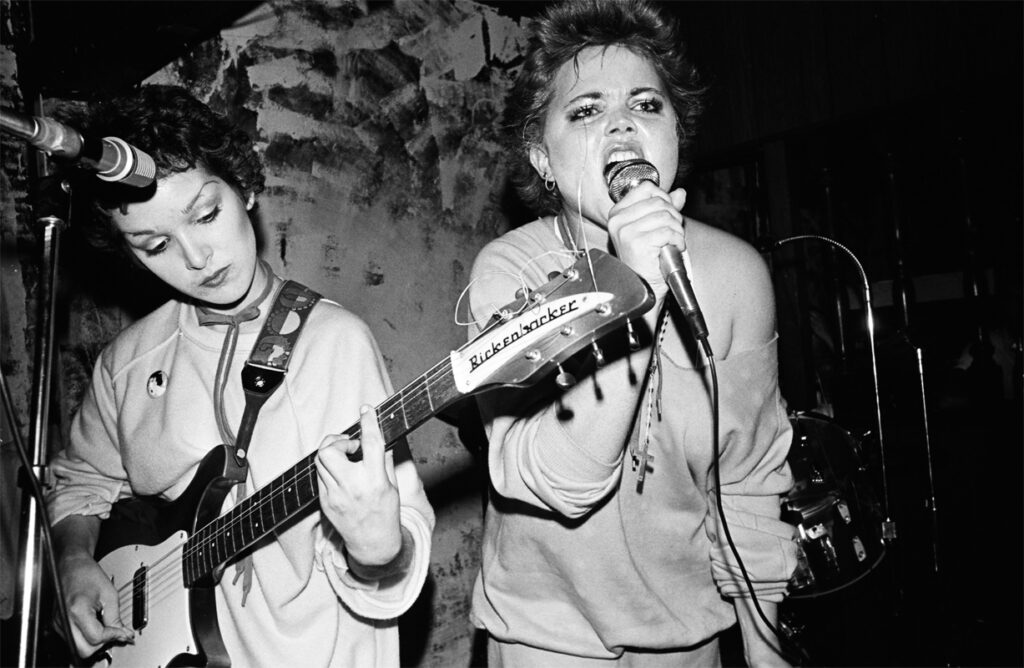With their first three albums—Beauty and the Beat (1981), Vacation (1982), and Talk Show (1984)—The Go-Go’s made history as the first all-female band who wrote their own songs and played their own instruments to top the charts. Forty years later, their hits such as “We Got the Beat,” “Our Lips Are Sealed” and “Head Over Heels” still stand as vibrant examples of perfect pop songs. In 2020, The Go-Go’s, a documentary about their rise to fame (and the struggles that sometimes engendered) premiered at the Sundance Film Festival, then aired on the Showtime channel, receiving high ratings and critical acclaim. On February 5, the film will be released on digital formats (via Mercury Studios).
Videos by American Songwriter
“I watched it as if it wasn’t me, as if it wasn’t my story, because it was so interesting and it drew me in so much,” says Go-Go’s guitarist/pianist Charlotte Caffey about the film, calling from her Los Angeles home. “And then I realized, ‘Wait, that’s us.’ To see it laid out like that, it’s really cool. It was very powerful to see that.”
Caffey wrote “We Got the Beat,” the band’s first Top 10 single, and co-wrote many of their other hits, as well. She remembers exactly when she realized she should become a songwriter and performer: “I saw The Beatles at Dodgers Stadium when I was twelve [years old],” she says. “I wasn’t screaming along with the rest of the girls. I was watching them intensely. In my mind I was like, ‘Oh, I’d like to do that.’”
By the time she was fifteen years old, Caffey was a proficient pianist who was writing her own songs. “I grew up listening to radio, and it’s kind of what formed me – the classic songwriting of the ‘60s and ‘70s was really the springboard for me,” she says, noting that the surf guitar style, so popular in Los Angeles at the time, had a particular influence on her later playing style. By her teen years, she was drawn to the punk scene happening in Hollywood.

“We started the Go-Go’s in 1978, I believe, and we were raw players, let’s put it that way,” Caffey says with a laugh. “We weren’t experienced being in a band. I had had classical training and I went to college for a degree in classical music on piano, but playing guitar was a whole ‘nother thing.”
Fortunately, the band’s inexperience wasn’t viewed as a problem in the punk world. “That scene we were in in Hollywood, that was the greatest thing for me as a songwriter because there was complete freedom,” Caffey says. “It was about expressing yourself, and everyone was welcome and being creative. It was completely out of control and wild. There were no restrictions.”
Still, Caffey recalls feeling some trepidation as she realized her songwriting was veering away from angry punk: “I brought in a song called ‘How Much More.’ I was really scared because it’s super pop and it’s about a relationship. I was like, ‘Well, I’m either going to get fired from the band, or maybe they’ll really like it!’” Fortunately, her bandmates loved the song. “Jane [Wiedlin, rhythm guitarist/backing vocalist] immediately jumped on board and helped me finish it.” The song later appeared on the band’s debut album.
“How Much More” may have ushered in a new pop vibe for the band, but plenty of their original angst still came through, blending together into a distinctive style. “As we played it live, we still sounded really raw and punk,” Caffey says, “so we had very melodic songs with a really rough edge when we were playing it live. That’s how our sound started.”
Caffey says she couldn’t have predicted that the band would go on to hit the charts and sell out stadium shows around the world —but she did know they were onto something special. “I remember thinking this a million times: ‘I think these songs keep getting better and better. Something is happening here.’ That’s what I kept thinking. The whole thing was really organic. It just came from our abilities at the time and our love for melodic songs,” she says.
The band would become role models for what women in bands could do – but again, Caffey says they didn’t realize at the time just how influential they were. “We could see, as our audiences grew, that there were women and girls in the audience, and it was so important to us,” she says. “We were so excited. That was really special. We really did have a sense that we were doing something special, but it wasn’t like we were saying, ‘We’re trailblazing.’”
As The Go-Go’s film shows, the band’s sudden rise to fame also had a dark side, leading to severe drug addiction for several members, and increasingly severe arguments between all of them, which eventually led to the band splitting up in 1985. With hindsight, Caffey calls their fighting “immature nonsense.”
The band went on to reunite and disband a few more times during the 1990s and into the 2000s, but Caffey says they’re in a healthy place now, with all members long sober and on good terms with each other. “Once we finally really started communicating with each other, then that’s when it really changed,” she says. “Now, if anything comes up, we talk about it and move on.” The Go-Go’s chronicles their successful reunion in 2019, which resulted in a tour and their first new single in almost twenty years, “Club Zero.”

Caffey says she and her bandmates are all looking forward to the post-pandemic world when they can again hit the road. “Our live shows, we actually have an incredibly fun time. The chemistry of the five of us together, I’ve never experienced it with any other people in my life,” she says. “It’s crazy. We really love playing. It’s not an act.”
Fans can also look forward to more new Go-Go’s songs, as Caffey confirms she and Wiedlin have agreed to use this time during the pandemic to start working together on new material—although she admits she can’t really explain what, exactly, makes a song right for the band. “There’s an element, there’s a special sauce, I don’t know what it is,” she says. “If I sit down and try to write a song for the Go-Go’s, it never works out.”
As a result, Caffey has a very free-form approach to songwriting (in keeping with the no-rules scene she started out in four decades ago). “What I do is stream-of-consciousness. I’ll sit down and start with the idea and let it go. I listen to some of my phone memos, because I put everything on my phone – it goes to some interesting places sometimes. That’s how I kind of feel out a song, feel out an idea. Sometimes I’ll start on guitar and I’ll be like, ‘Hey, I wonder what this would sound like on piano? Let me go over there.’ Then I start doing a whole different thing. I love the organic aspect of songwriting,” she says.
With The Go-Go’s documentary coming out on digital formats, fans will have another chance to experience the band’s story and timeless pop songs. While the film is candid about all the ups and downs in their career, Caffey says she and her bandmates are focusing on the good parts. “We’ve had incredible experiences and we’re all very grateful,” she says. “We have a good sense of humor about many things. We were very lucky. It’s an interesting history and I feel very, very fortunate to have it be mine.”
Main photo by Paul Natkin

Did you have to sign an agreement not to include Belinda Carlisle’s name in this article? I don’t know if she contributed to the writing of any of their songs, but to not even mention her name in an article about the GoGos is absurd. It makes anyone who really knows anything about the band spend the entire reading of the article wondering “when is something going to be said about Belinda?” Very aggravating.